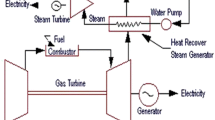Abstract
In recent years, interest in renewable energy as a substitute for power generation using coal has increased. As a next-generation power system, the Organic Rankine cycle (ORC) system, which requires a multi-stage turbine or a supersonic turbine to generate a high power, has been shown to have high potential for such uses. In this paper, a dense gas is chosen as a working fluid and a supersonic nozzle is designed for a supersonic turbine with advantages in terms of cost, power density and layout. Two stators are designed using the Method of characteristics (MOC) for air and dense gas. To validate the numerical model, the nozzle designed for the air is compared to that of a PIV experiment from the open literature, and the results indicate a reasonable agreement. The nozzle for the dense gas is different as that needed for air. Therefore, the modified MOC is applied based on a polytropic assumption. In conclusion, an estimation of the performance is implemented with loss coefficients for a different number of blades. The number of blades is shown to be proportional to the loss coefficient. For example, the case with the biggest numbers of blades is affected the most by the shock effect that occurs at the trailing edge.
Similar content being viewed by others
References
P. Colonna, E. Casati, C. Trapp, T. Mathijssen, J. Larjola, T. Turunen-Saaresti and A. Uusitalo, Organic Rankine cycle power systems: from the concept to current technology, applications, and an outlook to the future, Journal of Engineering for Gas Turbines and Power, 137 (10) (2015) 100801.
B. T. Liu, K. H. Chien and C. C. Wang, Effect of working fluids on organic Rankine cycle for waste heat recovery, Energy, 29 (8) (2004) 1207–1217.
U. Drescher and D. Brüggemann, Fluid selection for the Organic Rankine cycle (ORC) in biomass power and heat plants, Applied Thermal Engineering, 27 (1) (2007) 223–228.
T. C. Hung, Waste heat recovery of organic Rankine cycle using dry fluids, Energy Conversion and Management, 42 (5) (2001) 539–553.
B. F. Tchanche, G. Papadakis, G. Lambrinos and A. Frangoudakis, Fluid selection for a low-temperature solar organic Rankine cycle, Applied Thermal Engineering, 29 (11) (2009) 2468–2476.
V. Maizza and A. Maizza, Unconventional working fluids in organic Rankine-cycles for waste energy recovery systems, Applied Thermal Engineering, 21 (3) (2001) 381–390.
E. H. Wang, H. G. Zhang, B. Y. Fan, M. G. Ouyang, Y. Zhao and Q. H. Mu, Study of working fluid selection of Organic Rankine cycle (ORC) for engine waste heat recovery, Energy, 36 (5) (2011) 3406–3418.
Mitsubishi Heavy Industries News, MHI achieves 1600 °C turbine inlet temperature in test operation of world’s highest thermal efficiency ‘J-Series’ gas turbine, Available at http://www.mhi-global.com/news/story/1105261435.html.
M. Gaia, 30 years of ORC development, 1st International Seminar on ORC Power Systems (ORC2011), Delft, The Netherlands, Sept. (2011) 22–23.
S. Han, J. Seo and B. S. Choi, Development of a 200 kW ORC radial turbine for waste heat recovery, Journal of Mechanical Science and Technology, 28 (12) (2014) 5231–5241.
G. Vézina, H. Fortier-Topping, F. Bolduc-Teasdale, D. Rancourt, M. Picard, J. S. Plante and L. Fréchette, Design and experimental validation of a supersonic concentric micro gas turbine, Journal of Turbomachinery, 138 (2) (2016) 021007.
P. Cinnella and P. M. Congedo, Inviscid and viscous aerodynamics of dense gases, J. Fluid Mech., 580 (2007) 179–217.
G. Delussu and M. Talice, Inviscid supersonic minimum length nozzle design, Center for Advanced Studies, Research and Development in Sardinia (2002).
A. P. Wheeler and J. Ong, The role of dense gas dynamics on orc turbine performance, ASME Turbo Expo 2013: Turbine Technical Conference and Exposition (pp. V002T07A030-V002T07A030), American Society of Mechanical Engineers (2013).
J. John and T. Keith, Gas dynamics, Third Edition, Pearson International Edition (2005).
C. Dodson, Mathworks, Available at http://www.mathworks.com/.
Z. Chen, S. Yi, L. He, L. Tian and Y. Zhu, An experimental study on fine structures of supersonic laminar/turbulent flow over a backward-facing step based on NPLS, Chinese Science Bulletin, 57 (6) (2012) 584–590.
M. S. Cramer and A. B. Crickenberger, Prandtl-Meyer function for dense gases, AIAA Journal, 30 (2) (1992) 561–564.
A. C. Aldo and B. M. Argrow, Dense gas flow in minimum length nozzles, Journal of Fluids Engineering, 117 (2) (1995) 270–276.
E. W. Lemmon, M. L. Huber and M. O. McLinden, NIST Standard Reference Database 23, NIST Reference Fluid Thermodynamic and Transport Properties—REFPROP, 9 (2010) 55.
E. W. Lemmon and R. Span, Short fundamental equations of state for 20 industrial fluids, Journal of Chemical & Engineering Data, 51 (3) (2006) 785–850.
E. Rinaldi, R. Pecnik and P. Colonna, Unsteady operation of a highly supersonic organic Rankine cycle turbine, Journal of Turbomachinery, 138 (12) (2016) 121010.
H. Moustapha, M. F. Zelesky, N. C. Baines and D. Japikse, Axial and radial turbines (Vol. 2). White River Junction, VT: Concepts NREC (2003).
Author information
Authors and Affiliations
Corresponding author
Additional information
Recommended by Associate Editor Simon Song
Jongbeom Seo is a graduate student in the Department of Mechanical Engineering of Seoul National University of Science and Technology in Korea. He studies about turbomachinery, and heat and mass transfer analogy and obtained the Master’s degree from Seoul National University of Science and Technology in 2015.
Sangjo Han is an Assistant Professor in the Department of Mechanical Engineering of Seoul National University of Science and Technology in Korea. He obtained the Ph.D. degree from the University of Minnesota, USA, in 2004. He had worked at Samsung Electronics Co. for 2005-2008 as a Principal Investigator. For 2008-2011, he had worked at KIMM as a Senior Researcher. His research interests include heat and mass transfer, thermal process design, gas turbines, and organic Rankine cycle system. He can be reached at sjhan@seoultech.ac.kr.
Rights and permissions
About this article
Cite this article
Seo, J., Han, S. Supersonic turbine stator design using dense gas with numerical method. J Mech Sci Technol 31, 4297–4303 (2017). https://doi.org/10.1007/s12206-017-0828-3
Received:
Revised:
Accepted:
Published:
Issue Date:
DOI: https://doi.org/10.1007/s12206-017-0828-3




